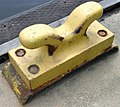Cleat
A cleat (also: Klampfe , mnd. To clamp ) is a device used in seafaring to fasten lines ( ropes ).
It has two opposing horns around which the line is wrapped alternately. The rope is held by the static friction with the horns of the cleat.
Normally, after two to three (crosswise) wraps around the cleat, a line experiences a frictional force that is greater than the strength of the line. Further " trips " (windings) on the cleat then no longer bring any advantages. The conclusion is the head blow , which also protects against unintentional loosening. Fastening a line to a cleat by means of suitable knots is nautically referred to as covering the cleat.
Cleats are screwed or welded onto their subsurface (for example the ship's deck or mast ). Cleats are available in different sizes and made of different materials, depending on the intended use and the forces to be absorbed.
Cleats should not be confused with bollards .
Heavy cast iron cleat on a harbor pontoon
Cleat with a leash covered with a head blow
Dalbe with cleat
Curved cleat in Key West




